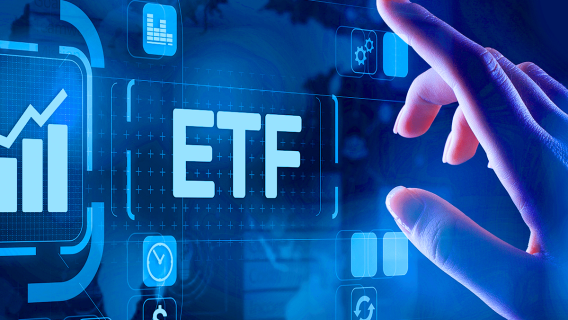Since exchange-traded funds were introduced nearly 30 years ago, these funds have been associated with major indexes.
On a certain level, that association still holds. The largest ETFs, by assets under management (AUM), all track major U.S. indexes. Because U.S. equities comprise more than 50% of global market capitalization, domestic index funds represent a crucial part of any American investor’s portfolio, as well as for non-U.S. investors.
Here are the largest ETFs by AUM:
- SPDR S&P 500 ETF Trust (SPY)
- iShares Core S&P 500 ETF (IVV)
- Vanguard Total Stock Market ETF (VTI)
- Vanguard S&P 500 ETF (VOO)
- Invesco QQQ Trust (QQQ)
In my newly launched advisory, I use major-index ETFs as the basis for a starting allocation, but you actually have some flexibility as to which funds you choose when accessing a particular asset class.
For example, I’ve built the initial portfolios using iShares ETFs, but if your 401(k) is like most, your ETF choices are limited. Fortunately, it’s possible to replicate an ETF portfolio using mutual funds. The tracking may not be exact, but you can generally get access to the broad asset classes (though 401(k) plans skew more heavily toward domestic funds than the Cabot portfolios), and you may pay more. Nonetheless, it’s possible to achieve at least some level of broad allocation.
If your company’s qualified plan only has a limited selection of mutual funds, or features names that don’t immediately make it clear what the fund holds, do some research before jumping in.
If you want to add alpha with sector, regional or theme funds, that’s tougher to do within a program like a 401(k). One idea might be to use these funds in a rollover IRA if you have one, or even in a taxable account.
You want to add these non-index funds to your core allocation thoughtfully. It’s important to avoid too much duplication or introduce a tilt toward an asset class unlikely to rally in the near to medium term.
If you’re not deliberate about this process, you risk doubling up on certain asset classes and holding an over-concentration in particular stocks. I’m not opposed to “fun money” holdings outside of an allocation, but don’t mix up the two. If you want to take a flier on a thematic, industry or regional ETF, you can treat it as money you’d spend playing blackjack at the Bellagio.
Another danger is owning risk assets that make no sense for your situation. For example, if your primary investment goal is to preserve capital and growth is secondary, then day trading a leveraged inverse ETF, such as the ProShares Short S&P500 ETF (SH), wouldn’t make sense.
If you choose to add funds outside a basic allocation, be sure you know what they are. To get an idea of how this might work for you, let’s take a look at some of 2021’s best performers. None track a major index.
The 5 Best-Performing ETFs of Last Year
- Breakwave Dry Bulk Shipping ETF (BDRY): Designed to reflect daily price movements of near-dated dry bulk freight futures
- iPath Series B Carbon ETN (GRN): Tracks the Barclays Global Carbon II Total Return USD Index, offering exposure to futures contracts on carbon emissions credits
- iPath Series B Bloomberg Tin Subindex Total Return ETN (JJT): Provides exposure to the Bloomberg Tin Subindex Total Return Index
- KraneShares Global Carbon Strategy ETF (KRBN): Benchmarked to IHS Markit’s Global Carbon Index, pegged to the most traded carbon credit futures contracts
- First Trust Natural Gas ETF (FCG): Seeks investment results that correspond generally to the price and yield of the ISE-Revere Natural Gas Index
As with any investment, past performance does not mean it’s time to go all in. The BDRY ETF returned 282.99% in 2021 but is down 24% YTD. The bulk (pun intended) of the fund’s gains came in the early months of 2021, as shippers were in high demand and had pricing power as supply-chain issues began heating up.
The ETF has been correcting since October. That’s precisely the kind of performance to monitor if you’re adding ETFs outside your core allocation. You don’t want to find your total return reduced because of an investment that was specifically intended to juice up returns.
It’s both fortunate and unfortunate that we’ll likely see a growing number of theme ETFs in the foreseeable future. It’s fortunate because investors will have more choices when it comes to adding alpha and diversifying. However, it’s unfortunate because many investors will buy into products they don’t understand, or are poorly designed and won’t deliver the hoped-for return, at least not without high fees.
Bottom line: Always know what you own, and why.
And if you need a helping hand to guide you through the sea of ETFs of all stripes, you can become an early subscriber to my Cabot ETF Strategist by clicking here. It’s an investment advisory devoted exclusively to exchange-traded funds.
Join me and let’s make a lot of money in ETFs together!
Kate Stalter is a Series 65-licensed asset manager, with more than two decades of experience in various areas of financial services. As an investment advisor and financial planner, Kate personally manages client portfolios, with a focus on successful retirement, including asset allocation, income generation and tax strategies.
Do you own any ETFs in your portfolio? Tell us about your best performers in the comments below.

